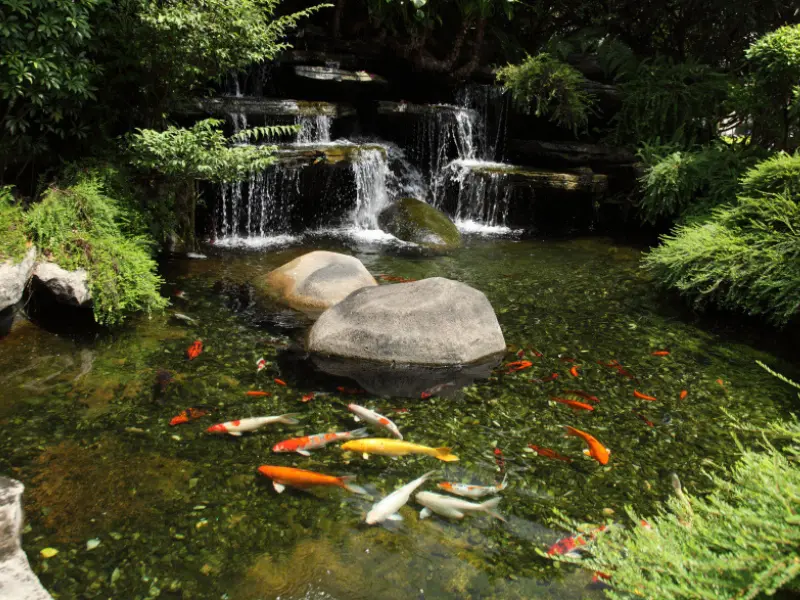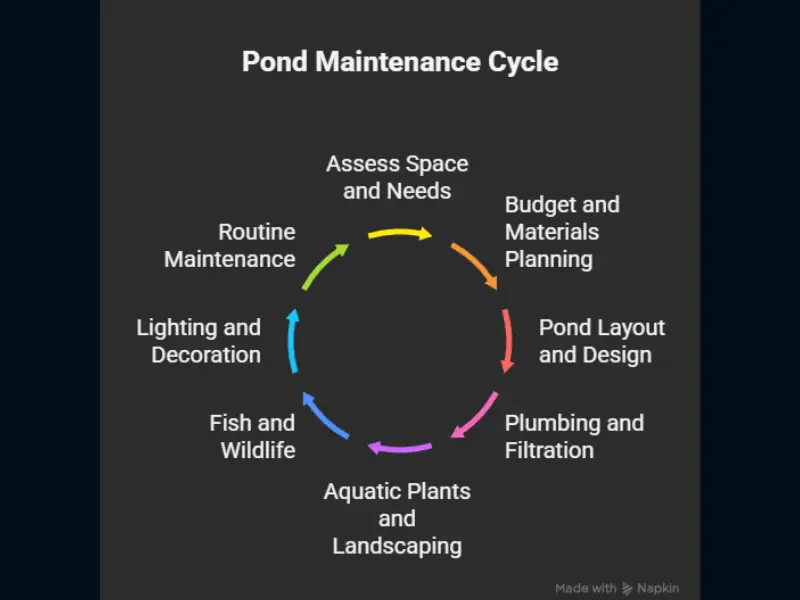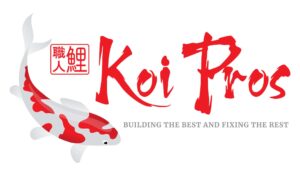
Planning a pond can feel overwhelming. There are many things to consider, from the shape and size to plants, fish, and water features. A well-planned pond will stay healthy and look great for years. In this guide, we will explain everything about pond design and planning, step by step. You will also learn why a pond design contractor can make a big difference and how to get a custom pond design that suits your space.
Why Pond Design & Planning is Important
A pond is more than just a hole with water. Without proper planning, it can become a maintenance problem. Proper pond design and planning ensures the pond works correctly and is enjoyable to use.
Benefits of Thoughtful Pond Planning
Planning your pond carefully helps you avoid common problems. It ensures water flows correctly, the ecosystem stays balanced, and your pond looks good. You also save money by avoiding costly mistakes.
DIY vs Professional Pond Design
Some people try to build ponds themselves. DIY is possible but comes with risks. Hiring a pond design contractor can save time, reduce mistakes, and give you a custom pond design that meets your needs.
Types of Ponds You Can Design
There are many pond types, each with different needs. Choosing the right type is the first step in planning.
Decorative Garden Ponds
These are small ponds made for beauty. They may include small fountains or simple water features.
Koi Ponds and Fish Ponds
Koi ponds need careful planning. Water depth, circulation, and filtration are critical. Fish health depends on the pond’s design.
Natural and Wildlife Ponds
These ponds support wildlife like frogs, birds, and insects. They often have plants and shallow edges to encourage animals to visit.
Water Garden Ponds
Water gardens combine plants and water features. They require a balance of sunlight, water quality, and plant types.
Step 1 – Assess Your Space and Needs

Before building a pond, evaluate your yard and needs. This step saves problems later.
Choosing the Right Location
Sunlight is important. Most ponds need 4-6 hours of sun daily. Avoid placing ponds under large trees. Roots and falling leaves can cause problems.
Determining Pond Size and Shape
Consider your yard size and purpose. Small ponds are easier to maintain. Large ponds can hold fish and bigger plants. Shape matters too. Natural curves are easier to integrate, while geometric shapes are formal and modern.
Planning for Accessibility
Think about maintenance access. Make sure you can reach the pond edge safely. Include space to clean, check pumps, or feed fish.
Step 2 – Budget and Materials Planning
Pond planning includes budgeting. Knowing costs helps avoid surprises.
Estimating Costs
Construction, materials, pumps, plants, and fish all add up. Small ponds may cost $2,000–$5,000. Large ponds can reach $10,000 or more.
Selecting Materials
Common materials include pond liners, rocks, gravel, pumps, and filters. Quality materials last longer.
Custom Pond Design vs Standard Kits
Standard kits are cheaper but limited in design. A custom pond design from a contractor can fit your yard perfectly. It also allows adding features like waterfalls or special plant areas.
Step 3 – Pond Layout & Design
Layout and design set the pond’s function and look.
Designing Your Pond Shape
Plan different depths. Include deep zones for fish and shallow areas for plants. Curves look natural, while straight lines are easier to install.
Incorporating Water Features
Fountains, waterfalls, and streams make the pond lively. They also help water movement and prevent stagnation.
Planning Zones in the Pond
Divide the pond into zones. Deep areas for fish, shallow edges for plants, and mid-depth areas for aesthetics.
Safety Considerations
Depth can be a hazard for children or pets. Shallow edges or fences can help prevent accidents.
Step 4 – Plumbing, Pumps, and Filtration
Water circulation is key. Without it, ponds can become dirty quickly.
Importance of Proper Water Circulation
Stagnant water grows algae. Circulation keeps water healthy and oxygenated.
Choosing the Right Pump
Pumps should match pond volume. Water features like waterfalls require stronger pumps.
Filtration Systems
Mechanical filters remove debris. Biological filters maintain water quality. A good system keeps fish and plants healthy.
Step 5 – Aquatic Plants & Landscaping
Plants improve the pond environment. They provide oxygen and shade.
Choosing Plants for Your Pond
Include different types: marginal (edges), floating, and submerged. Each has a purpose. Marginal plants hide edges, floating plants reduce algae, and submerged plants oxygenate the water.
Plant Placement and Benefits
Plants reduce algae by competing for nutrients. They provide shelter for fish and add color.
Surrounding Landscaping
Rocks, gravel, and small paths around the pond create a finished look. Landscaping helps blend the pond with your yard.
Step 6 – Fish and Wildlife Considerations
Fish and wildlife bring life to your pond.
Selecting Fish Species
Koi, goldfish, or native species are common. Choose fish that match pond size and depth.
Fish Health and Safety
Check water temperature, oxygen levels, and pH regularly. Avoid overcrowding fish.
Attracting Wildlife
Add plants and shallow areas for frogs or birds. Avoid chemicals that harm animals.
Step 7 – Lighting and Decorative Elements
Lighting extends pond enjoyment to evenings.
Pond Lighting Options
Use submersible lights or spotlights. Lights highlight plants, fish, or water features.
Decorative Elements
Add rocks, bridges, statues, or benches. Decor complements the pond without obstructing maintenance.
Step 8 – Maintenance Planning
A pond needs care to stay healthy.
Routine Cleaning and Care
Remove leaves, check pumps, and clean filters weekly or monthly.
Seasonal Maintenance
Winterizing is important in cold climates. Cover pumps or move fish indoors if needed. Spring clean-up prepares the pond for summer.
Troubleshooting Common Problems
Algae growth, murky water, or leaks are common. A pond contractor can help fix serious problems.
Hiring a Pond Design Contractor in Orange County
Hiring a professional like Koi Pros in Orange simplifies pond creation. Their expertise in pumps, filtration, and ecosystem balance helps avoid costly mistakes.
Choosing the Right Contractor:
- Check past projects and reviews
- Verify certifications
- Ensure experience with your pond type
Koi Pros offers custom pond design, maintenance, waterfalls, and filtration services, ensuring a healthy and beautiful pond.
Cost Considerations
Pond costs depend on size, materials, and features.
Construction Costs
Excavation, liners, pumps, plants, and water features. Larger or complex ponds cost more.
Maintenance Costs
Regular maintenance includes cleaning, filter replacements, and water testing.
Long-Term Investment
A properly designed pond adds value to your property and reduces repair costs. Professional design helps protect your investment.
Mistakes to Avoid in Pond Design
Planning carefully prevents common mistakes.
- Poor location selection. Avoid too much shade or too many tree roots.
- Wrong liner or materials. Cheap liners may leak.
- Poor water circulation. Stagnant water grows algae.
- Overcrowding fish or plants. Too many living things hurt pond health.
- Neglecting maintenance. Even a small pond needs care.
Frequently Asked Questions (FAQ)
How long does it take to design and build a pond?
It depends on size and complexity. Small ponds may take a few days. Large ponds can take weeks.
Can I add fish later?
Yes. Many people build the pond first and add fish after water conditions stabilize.
What type of pump is best?
Pumps depend on pond size and water features. A contractor can recommend the right one.
Do I need professional maintenance?
Basic cleaning can be done at home. Professional maintenance ensures healthy water and fish.
How deep should a pond be for fish?
Fish need at least 2–3 feet in the main area. Koi may need more for winter survival.
Conclusion
A pond is more than water. Proper pond design and planning ensures it works well, stays clean, and looks good. Step-by-step planning includes choosing the location, pond type, plants, fish, and water features.
A pond design contractor can help with custom pond design, construction, and maintenance. Professionals save time, prevent mistakes, and ensure your pond lasts for years.
Whether you plan a small backyard pond or a large koi pond, careful planning makes all the difference. Start with your needs, consider your space, and make a plan. With the right steps, you can enjoy a healthy and beautiful pond for years to come.
